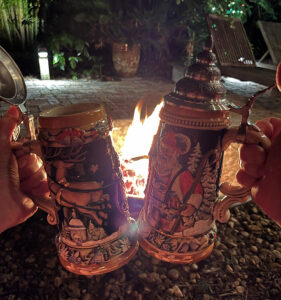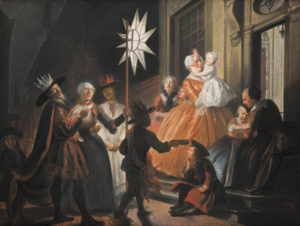The Sixth of January brings Epiphany, the Twelfth Day of Christmas by our method of counting six days in the old year and six in the new, with Yuletide in its constant role, bridging us across the years: ending our years, starting our years. No wonder, then, Christmas is such an extraordinary time.
For most, Epiphany is the close of the Christmas season. It is said the Magi, who had been following the star through the desert land for twelve days, finally reached the child in the barn on this day. Seeing the child was their great epiphany, and in turn, ours. Epiphany is a celebration even older than Christmas itself. The Church early on recognized that Epiphany holds the great symbolism that this news of the savior’s birth was for all people. The Magi are not from Judea. They are from distant lands. By journeying for twelve days and paying homage to the child, the Magi show that the message is universal.
In our home, we close the main celebration of Christmas on Epiphany night with a simple ceremony at the front door, outside on the front porch. We will gather up all who are in attendance (which very often is just Seth and me) and we will each take turns writing with chalk on the lintel above the front door the numbers and letters and symbols of a traditional inscription. This year, it will read as follows: 20+C+M+B+25. These are the initials of each of the Three Kings (C for Caspar, M for Melchior, B for Balthasar), punctuated by crosses, blanketed on either side by the year. I tell you this each and every year: For me, the inscribing is always accompanied by a silent prayer that no one will be missing when we gather next to write the inscription again. Depending on the weather, the inscription may be there above the door for a month or it may be there all the year through. And though Christmas be gone, still the inscription reminds us of its presence as we pass each day through that portal. The inscription is a magic charm of sorts, protecting the house and those who pass through the doorway, harboring the goodwill and spirit of the Christ Child, and of the Three Kings, and of Old Father Christmas, too.
It is those Three Kings, the Magi, who bring presents to children in Spain and Latin America. This, done in the overnight hours of Twelfth Night, or Epiphany Eve, which comes upon us as the Fifth of January becomes the Sixth. The Magi are some of the last of the Midwinter gift bearers, but they are not alone, for in Italy, on this same night, la Befana, the kindly old witch, makes her rounds on her broomstick delivering her presents. La Befana is tied to the Three Kings story, for, as the legend goes, the Magi and their grand procession happened to stop by her house as they set out on their journey that first starry night. They asked her to accompany them, but she said, “No, I can’t; I have far too much housework to do.” And I have known so many Befanas in my day: Italian women who are busy, busy, with no time to do anything else but keep the house clean and keep their families fed. It’s a tough job. My family is full of women who would probably say no to the Magi, too, if they were to knock on the door.
And so Caspar, Melchior, and Balthasar went on their way, with their retinue and with their camels and with their gifts for the child of frankincense, gold, and myrrh. And as they went on their way, processing forth, la Befana picked up her broom, and began sweeping her home. She swept all the corners of all the rooms, and she swept her pathway, too, to the road. And as she swept and swept, she grew remorseful for not accepting the invitation of the Magi, and so, she decided, she would go and join them after all. But by the time she left her home, the Magi and their retinue were no where to be found. She got on her broom and flew here and flew there, and she searched and searched, but la Befana never found the Magi, and she never found the child. And each year now, on the Eve of the Epiphany, she searches again, in hopes of finding the Christ child. As she searches, la Befana brings presents for the children who have been good, and coal for the children who were not so good in the past year. But even her coal is not so bad a present, for it is usually sweet candy shaped like coal. (La Befana, is, after all, a kindly old witch.)
It is la Befana’s job, too, to sweep away Christmas for another year, and as she does, we return to ordinary time and the workaday world. But if you love Christmas as much as we do in this house, I bring you tidings of good news: your celebration need not necessarily end here with the close of the Twelve Days of Christmas. Though the major part of the celebration is done, the poet Robert Herrick reminds us that it is fine and good, too, to keep the Christmas greenery in your home for the rest of the month of January. This practice follows the ancient customs of his day, and we, here, each year follow Herrick’s lead. It is good at this point to put away many of the more contemporary decorations for the season, but it is perfectly fine, by this custom, to keep the greenery, to keep the candles and the stars and the lights on the tree. As long as the greenery is gone by Candlemas Eve, Herrick says, all is well. Candlemas Eve: the First of February, the Eve of St. Brigid’s Day, honoring Brigid, who bridges us from winter to spring. Robert Herrick’s approach is, we feel, a most sensible approach to Christmastide and the wheel of the year (especially if you, like we, are in love with Christmas).
TWELVE DAYS of CHRISTMAS SALE
At the shop, we are back to our regular hours: Saturdays from 11 AM to 4 PM, with occasional special events as well as hours by appointment. We absolutely loved seeing you at all of our Christmas Markets this past December, and we look forward to seeing you more in 2025. This Saturday at the shop (as well as online), our Twelve Days of Christmas Sale continues (a little longer than planned), with rare temporary markdowns on many of our Christmas items, as well as clearance prices on Christmas specialty foods, chocolates, and cookies. CLICK HERE to shop, or come see us this Saturday from 11 to 4 at the shop. The address is 1110 North G Street, Lake Worth Beach, FL 33460.
Twelfth Night fire in the chilly Lake Worth January air with roasted chestnuts and Rhineland steins of St. Bernardus Christmas Ale: It was a fine night.


